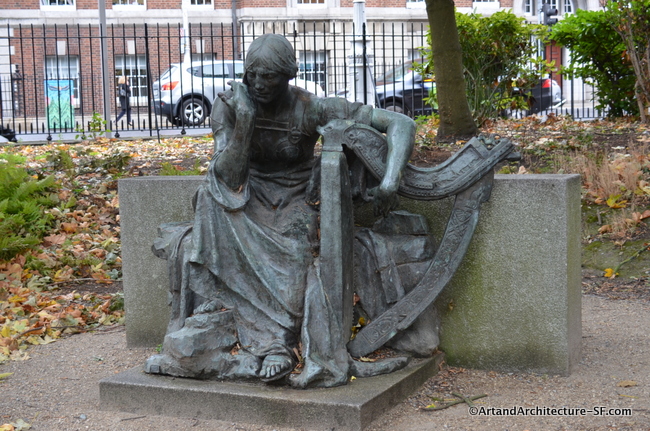Merrion Square
Dublin, Ireland
 Éire by Jerome Connor
Éire by Jerome Connor
Jerome Connor (February 1874 – August 1943) was born in Coumduff, Annascaul, Ireland. He was the sixth and youngest son of Patrick and Margaret Connor.
The family moved to Holyoake, Massachusetts in the 1890s.
Jerome ran away from home and settled in New York. After trying many trades (foundry-man, professional prize fighter, machinist, sign painter, Japanese intelligence officer in Mexico, and stonecutter) he became a sculptor.
His most notable sculptures are in Washington D.C.: statues of Robert Emmett (a cast of which is in Dublin) and Bishop John Carroll, and the Nuns of the Battlefield tablet.
When the Irish Free State achieved independence in 1922, Connor returned to Ireland
In 1925 he won a prestigious commission from a New York committee to create a monument in Cobh, County Cork to commemorate the lives lost in the sinking of the Lusitania. Sadly, eighteen years later, at the time of his death, the project had not been completed. Connor had become a bankrupt and alcoholic, and died in a Dublin slum at the age of 67. The Lusitania Monument was eventually completed by another artist.
In 1928 Jerome Connor became involved in a proposal to create a memorial to the Kerry poets, which was to commemorate four leading Gaelic poets of the 17th and 18th centuries. He chose a figure of Éire holding a harp seated on a rock, possibly inspired by Walt Whitman’s poem Old Ireland in Leaves of Grass (1861). The unstrung harp was based on the 1621 Cloyne harp in the National Museum. The work went as far as a full-scale replica in wax.
Éire was cast in bronze in Dublin many years after Connor’s death. It was erected in Merrion Square, without a title or an acknowledgment of the sculptor. It has a plaque inscribed “This statue was presented by Joseph Downes and Son Ltd. in Dec. 1976 to commemorate the centenary of the ButterCrust Bakery, Dublin”.